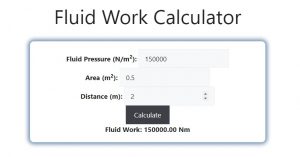About Fluid Work Calculator (Formula)
The Fluid Work Calculator is an essential tool for engineers and physicists who need to determine the work done by fluids in various applications. It helps in analyzing systems where fluids are in motion and performing work on their surroundings. Understanding fluid work is crucial in fields such as hydraulics, thermodynamics, and fluid dynamics. This calculator simplifies the process of calculating fluid work, allowing users to focus on design and analysis without getting bogged down by complex calculations.
Formula
The formula to calculate the work done by fluid (Wfluid) is:
Wfluid = P * A * s
Where:
- Wfluid is the work done by the fluid.
- P is the pressure of the fluid.
- A is the area through which the fluid acts.
- s is the displacement or distance the fluid moves.
How to Use
Using the Fluid Work Calculator involves a few simple steps:
- Determine the Pressure (P): Measure or obtain the pressure of the fluid acting on the area in question. This is typically measured in pascals (Pa) or other pressure units.
- Measure the Area (A): Calculate the cross-sectional area (in square meters) over which the fluid is acting. This could be the area of a piston or any surface in contact with the fluid.
- Measure the Displacement (s): Determine the distance (in meters) that the fluid has moved or displaced in the process.
- Input Values: Enter the values for pressure (P), area (A), and displacement (s) into the calculator.
- Calculate the Work: Click the calculate button to find the work done by the fluid.
Example
Let’s consider an example where you want to calculate the work done by a fluid with the following parameters:
- Pressure (P): 150,000 Pa (or 150 kPa)
- Area (A): 0.5 m²
- Displacement (s): 2 m
Using the formula:
Wfluid = P * A * s
Wfluid = 150,000 Pa * 0.5 m² * 2 m
Wfluid = 150,000 * 0.5 * 2
Wfluid = 150,000 J (Joules)
Thus, the work done by the fluid is 150,000 Joules.

FAQs
- What is fluid work?
Fluid work is the energy transferred by a fluid in motion as it exerts pressure on a surface over a distance. - Why is the Fluid Work Calculator important?
It provides a quick and accurate way to calculate the work done by fluids, which is essential in many engineering applications. - What units are used in the calculations?
Pressure is typically in pascals (Pa), area in square meters (m²), and displacement in meters (m). - Can I use this calculator for any type of fluid?
Yes, the calculator is applicable for any fluid, whether it be liquid or gas, as long as you have the necessary parameters. - What if I have varying pressure?
If the pressure varies, you may need to calculate the work done over specific intervals and sum them up. - Is this calculator suitable for both theoretical and practical applications?
Yes, it can be used for both theoretical calculations in research and practical applications in engineering. - How do I ensure accurate measurements?
Use precise measuring instruments for pressure, area, and displacement to ensure accurate input values. - What other factors can affect fluid work?
Factors such as temperature, viscosity, and fluid density can affect the work done by the fluid. - Can the calculator handle multiple inputs?
Typically, the calculator is designed for single inputs at a time. For multiple scenarios, run the calculations separately. - What happens if the displacement is zero?
If displacement is zero, the work done will also be zero, as no movement means no work. - How does the area affect the work done?
A larger area will result in more work done, assuming pressure and displacement remain constant. - Is this calculator applicable in HVAC systems?
Yes, the Fluid Work Calculator can be used in HVAC systems to evaluate work done by refrigerants and air. - Can I use this calculator for compressible fluids?
Yes, but you may need to account for additional variables like changes in pressure and volume. - What is the significance of pressure in fluid work?
Pressure determines how much force is applied over an area, directly affecting the amount of work done. - How does temperature influence fluid work?
Temperature can affect fluid density and viscosity, potentially impacting pressure and work calculations. - Can the Fluid Work Calculator be used in simulations?
Yes, it can be integrated into simulations for analyzing fluid dynamics and energy transfer. - What software tools might use this calculator?
Engineering simulation software, thermodynamic analysis tools, and fluid dynamics modeling applications often incorporate fluid work calculations. - What types of engineering utilize fluid work calculations?
Mechanical, civil, and chemical engineering fields often use fluid work calculations for design and analysis. - What is the relationship between fluid work and energy conservation?
The work done by fluids is a form of energy transfer, and understanding this is crucial for energy conservation analyses. - How can I improve my calculations for better accuracy?
Regularly calibrate your measuring devices and consider all environmental conditions that may affect fluid properties.
Conclusion
The Fluid Work Calculator is an invaluable tool for professionals dealing with fluid dynamics and energy transfer. By providing an easy way to calculate the work done by fluids, it enhances understanding and efficiency in engineering applications. Whether you’re designing hydraulic systems or analyzing fluid behavior, this calculator helps streamline your calculations, leading to better decision-making and project outcomes.